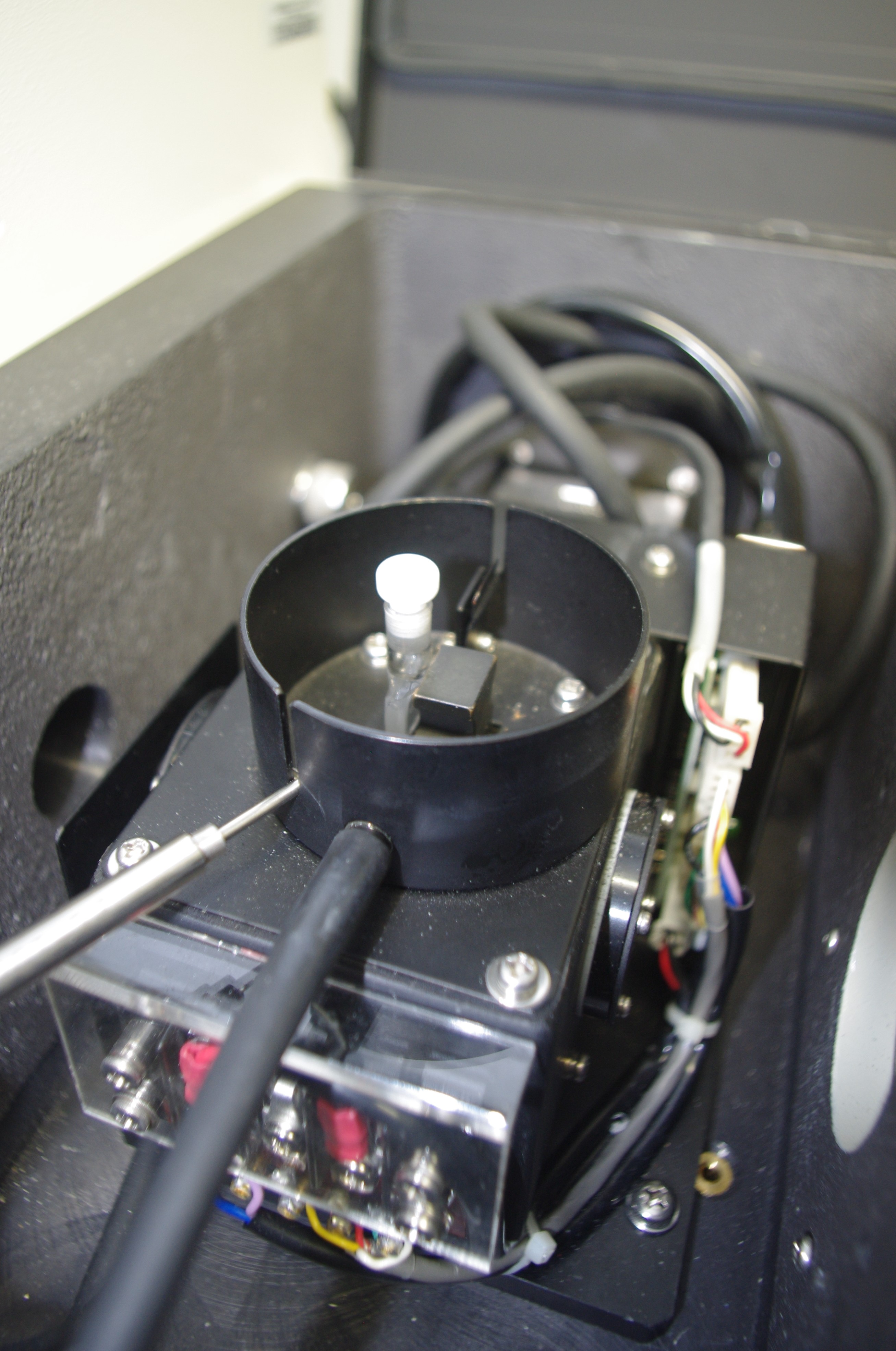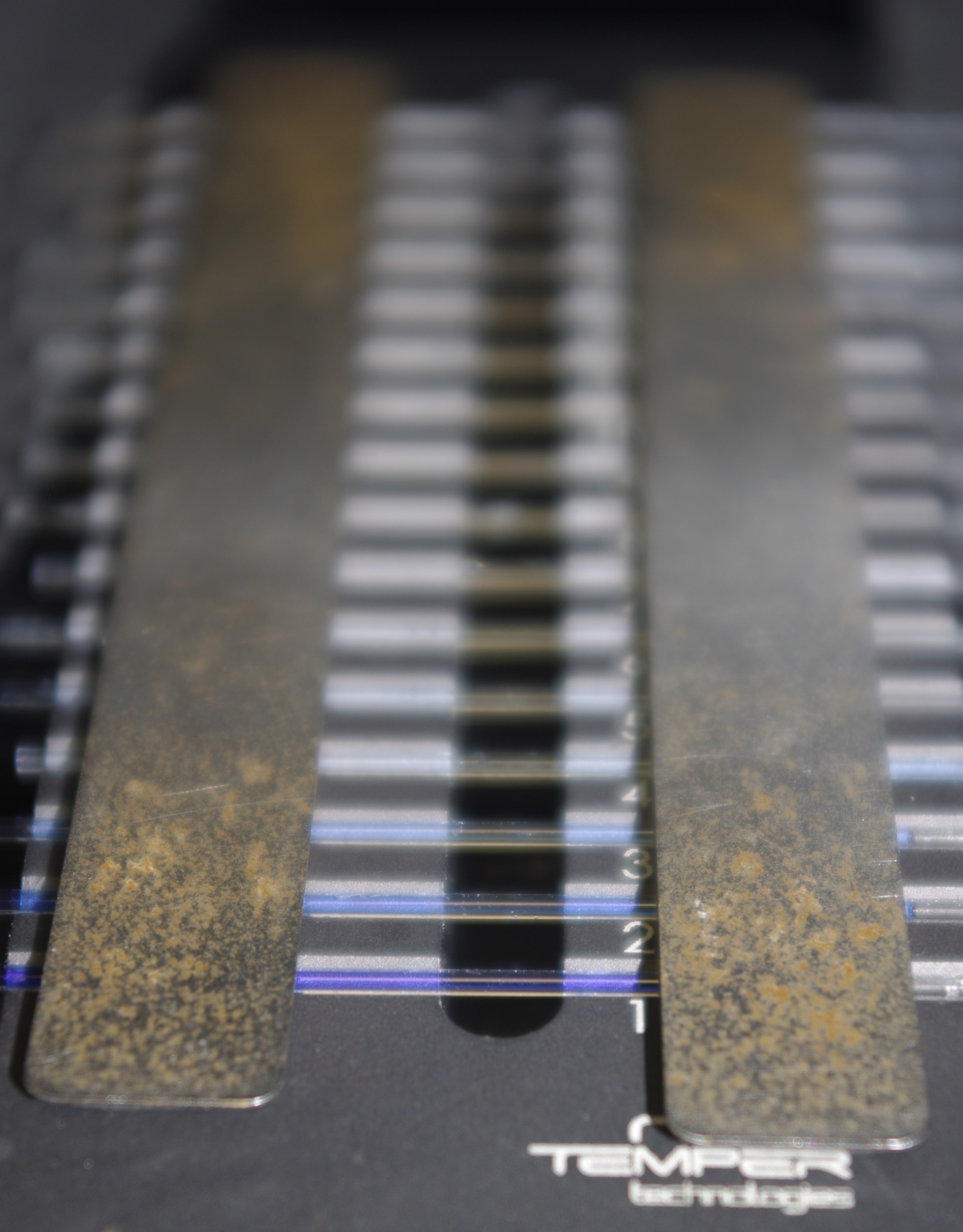Equipment
Circular Dichroism (CD)
Circular Dichroism (CD) measures the difference in absorption of left- and right-handed circular polarised light of samples. The absorption in the far-UV spectrum reveals information about the secondary structure of the protein. Although the amount of information is limited (e.g. percentage of beta-sheets in a protein), this method is very useful for getting well-defined melting curves or proof of the overall structural identity of point mutations.
Pro
- low protein need (~ 0.1 mg/ml in 150µl)
- very accurate melting curves.
Con
- Very limited structural information
- Should be done in low salt buffer (ideally 5mM phosphate buffers)
Users of the PIPC can get access to a JASCO J-715, equipped with a Peltier-coupled cuvette cooler. Based on the time needed for measurement users might be asked to participate in paying the necessary N2 costs.
More info about the physical basics on WIKIPEDIA
Bio-layer interferometry (BLItz)
In Bio-layer interferometry (BLItz) the difference in total reflection of white light is measured in dependence of macromolecules attaching to the tip of an optical fibre. Typically a protein of interest (ligand) is coupled to a biosensor (e.g. via its biotin- or His-tag) and incubated with various concentrations of ligand. The system observes the association and dissociation in realtime, which can later be fitted to determine binding affinity. The BLItz system is a very cheap, brilliantly fast system, giving your kinetic and affinity parameters for your interaction. Because of the diverse biosensors, immobilising ligands is versatile and simple. However, non-specific binding (NSB) of the analyte to the biosensors and problems with immobilisation of your ligand might cause problems. Overall the system behaves similar to an SPR system, with less costs, but more hands-on time required.
Pro
- Cheap
- Kinetics
- Fast assay development
Con
- sometimes problems with NSB
- Fitting kinetic data is not always straight-forward if they do not follow a 1:1 stoichiometry
Users of the PIPC can get full access to the BLItz. For initial testing or small assays sensors can be bought from the facility (see price list).
More info about the physical basics on WIKIPEDIA
Isothermal titration calorimetry (ITC)
With Isothermal titration calorimetry (ITC) you measure directly the changes in enthalpy (i.e. the generation or absorbance of heat energy) during complex formation. The measurement takes place by successively injecting an analyte from a syringe into a small cavity containing the ligand, measuring the change of heat capacity upon mixing. The beauty of the method is that you, firstly, do not need to label any of your components and secondly, can directly infer the stoichiometry of your complex. You also directly get thermodynamic parameters not accessible by any other method. However, you need a lot of protein, carefully prepared to prevent buffer artefacts.
Pro
- Only method for thermodynamic parameters
- Complete label-free (no label at all necessary)
- Cheap - in terms of consumable
Con
- Typically needs lots of protein (milligram range/measurement)
- very sensitive to preparation errors, needs practise.
- no kinetics
P2Pc members have access to an autoITC and several manual VP-ITC, all from Malvern Instruments (formerly GE Healthcare)
More info about the physical basics on WIKIPEDIA
MicroScale Thermophoresis (MST)
MicroScale Thermophoresis (MST) is a great method to detect interactions in a general way. As both components (ligand & analyte) are always in solution there are no problems with immobilisation. Furthermore, it is even possible to detect the interaction of single small molecules (up to ions) to larger macromolecules, as the method is sensitive to changes in charge, hydration shell and mass of the formed complex. However, one interaction partner must be labelled fluorescently.
Pro
- low sample volume (only a few µl of protein needed)
- in theory no size limit for the analyte
- fast assay development (if works, can be performed in a couple of hours)
- relatively cheap (16 capillaries à 40ct each ~ 6.50 € each measurement)
Con
- Ligand (called "target" in MST) must be fluorescently labelled.
- Does not always work - even with known interactions
- You only get at KD (no kinetics / Thermodynamics)
PIPC users can get acces to a Nanotemper Monolith NT.115 equipped with blue and red diodes.
More info about the physical basics on WIKIPEDA
Surface plasmon resonance spectroscopy (Biacore)
Surface plasmon resonance spectroscopy - often called Biacore - detects the addition of mass on a chip in dependence on time. Typically the ligand is immobilised by NHS chemistry on the surface of a dextran covered chip and incubated with variable concentrations of analyte. The system detects the association and dissociation of analytes towards the ligand in real-time and, thereby, allows to characterise the kinetic parameters of an interaction. Costs for chips are high, but typically rewarded by very good data. Similar to other assays using immobilised ligands, the assay is prone to non-specific bindings. Normally Biacore systems are well automated and need very little user intervention. However, due to the complicated liquid handling system a thorough introduction to the system is necessary.
Pro
- "Gold Standard" in protein kinetics
- After assay development very few hands-on time
- Reliable & reproducible data
Con
- Expensive chips
- Hard to use / complicated machine
- Difficult to analyse if the interaction is not 1:1
- some problems with NSB
Users of the PIPC can get access to a BiaCore X100. However, as extensive training is necessary for that device a collaboration approach would be advisable if only a few measurements are needed. Chips need to be bought by the users directly.
More information about the physical paramters on WIKIPEDIA

